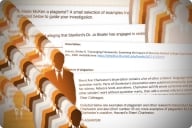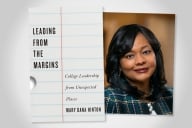You have /5 articles left.
Sign up for a free account or log in.
Many college leaders profess that they are committed to diversifying their faculties. But results are decidedly mixed. A new book, An Inclusive Academy: Achieving Diversity and Excellence (MIT Press), suggests that colleges need to be doing much more than they are now if they are to succeed. The authors are Abigail J. Stewart, the Sandra Schwartz Tangri Distinguished University Professor of Psychology and Women's Studies at the University of Michigan, and Virginia Valian, Distinguished Professor of Psychology, Linguistics and Speech-Language-Hearing Sciences at Hunter College and the Graduate Center of the City University of New York.
Via email, they responded to questions about their book.
Q: These days so many colleges say they are deeply committed to diversifying the faculty. Your book suggests otherwise. Why do you think colleges aren't matching their statements with actual actions?
A: We think that, by and large, colleges are sincere in their commitment to diversifying the faculty. Several factors stand in the way of their following through on that commitment. We highlight only a few here.
First, people genuinely aren't sure what to do; they especially aren't sure where to start. They tend to start with actions like developing mentoring programs. Mentoring is useful, and we describe what we think are effective programs in our book, but mentoring doesn’t get to the heart of institutional procedures that make diversifying the faculty difficult. Second, there is a belief in the essential goodness of the institutions and their procedures, which can lead to anxiety that changing them will risk their good qualities. Third, individuals don't realize how their own actions and features of everyday institutional life can create an environment that is more or less inclusive. Fourth, it takes a continual effort on multiple fronts to change institutions. There's no single action one can take once and for all that fixes the problem. So often people get discouraged before they see that the actions they are taking are having good effects!
Q: Some colleges have much more success in some disciplines (education and some humanities fields). Your book suggests that these efforts must be across the board. Why is that important?
A: There are two different issues to think about in your question. Can we learn from successes in some fields how to diversify others? The answer to this is yes, but only a little. For one thing, very few fields have racial-ethnic diversity that reflects our population; the successes are mainly in gender diversity. So virtually all fields need to be more inclusive. In addition, there are likely different factors at work in different fields, and they need to be evaluated carefully. Which brings us to the second question: Are some of the problems beyond the disciplines? We think the answer is yes; institutions of higher education share some common practices and procedures that we believe hamper efforts toward greater inclusion in all fields. It makes sense to look for institution-level solutions for those.
Q: Search committees have tremendous power in hiring faculty members. How can colleges make sure their search committees are casting a wide net for talent?
A: Start by considering how you define your position; we recommend a broad description. We recommend that because you will get a broader range of talent and you will learn what new areas -- areas that you might not have considered -- are developing. Search committees also should be deliberate about using criteria that they debate and agree on in advance of reviewing any candidates, and should adopt procedures that ensure that they assess all the candidates in terms of all of those criteria. And they should be careful to avoid substituting proxies for excellence (such as judgment of the prestige of their adviser) for evaluations of excellence (their own review of the candidate’s work).
Q: How do you answer those who say "we just can't find qualified" candidates of certain groups?
A: Indeed! This is the most common response we hear. Our easy answer is look harder -- women and people of color are there. Our more complicated answer is to learn what the potential applicant pool looks like so that you can at least match the pool's percentages. We are very data oriented. We provide a sample form that the University of Michigan supplies departments with; it has information about the pool. Then you have to figure out how to encourage applications from groups that might be skeptical about your sincerity, following up with phone calls.
Q: Are there efforts you have noted at any colleges that have made a real impact? Can you describe what made a difference?
A: Different efforts will work in different places. The University of Michigan has had great success with its STRIDE program, where two or three well-respected faculty who know the literature, despite coming from many disciplines, present cross-departmental workshops to those who are searching and bring them up to speed. Another successful practice is short list review: deans at some institutions have turned down requests to interview candidates when departments have not shown a wide range of potential candidates. Deans have also offered extra funds to departments to bring in more candidates so that the short list will be more diverse.
Q: Nationally, and not just in higher education, we seem to be in a period of increased tensions over race, with national leaders using decidedly noninclusive rhetoric, and campuses regularly facing racial incidents. Is the work to diversify the faculty more difficult in this environment?
A: We would turn this question around. Faculty have the opportunity right now to use questions about race, ethnicity and gender as a way to educate themselves and their students. Above all, faculty are committed to the ideas of fairness and merit. Yet they do not necessarily know how to make fair and impartial evaluations. Ironically, faculty believe so much in their own fairness that they do not see where their judgments are in error. In our book, we review data on evaluations that show what kinds of mistakes are likely.








